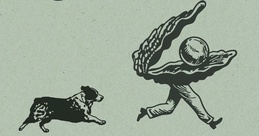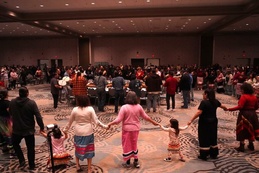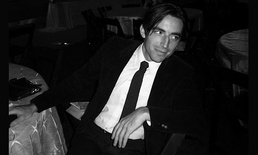The Quilt Maker
May 10, 2006
After my husband used to rearrange the living room furniture just so, he’d joke: “I’m a man and a woman, too!”In artistic terms, the same could be said of David Lint, M.D., only he is a little older and has achieved great things with… quilts. You can see his creations hanging in the spacious, historic corridor of the Minervini Group offices until May 19th.Prepare to be amazed, even if you’re not a quilt aficionado.
They were created by an amazing man. Lint, a retired orthopaedic surgeon, is a rare breed, a renaissance guy. He enjoys bird hunting with his arthritic dog, hunting for morels, and ski racing. He plays classical violin and once tried to raise ostriches (but not successfully).
Stitching together a new life
Lint was introduced to quilting by his wife, Mary, a gifted quilter in her own right. But his decision to try it himself came after visiting John Liddicoat, a long-time friend and a retired heart surgeon. He and Mary went to Liddicoat’s Bay Harbor condo in 2002, at a time when Lint was winding down his practice. He admired Liddicoat’s long-arm sewing machine, an expensive contraption that allows you to sew the intricate designs on very large and thick pieces of cloth.
Liddicoat challenged him to sew a quilt of his own, and he did during the overcast, rainy days of that Traverse City autumn. Lint was immediately hooked. His quilts grew bigger and more intricate. He quickly rationalized how he needed his own long arm machine and bought one for $12,000.
But Lint acknowledges he’s really a novice compared to veteran quilters and admitted to being a little embarrassed about the exhibit.
“The women quilters I’ve met undervalue their abilities --‘My quilts aren’t good enough.’ But then they’ll look at these and say, ‘These aren’t so hard!’”
And Lint would agree with them. But Lint, who wore a vivid, grape-colored shirt the morning I met him, allows that he has a good eye for color and fabric design. He shops fabric stores across the country and talks proudly about his bargains. He showed me how he quilted different fabrics together that when seen alone would have no business stitched side by side. But they look gorgeous together.
“The batiks are my favorite. As you put this block together and then this block, the quilt begins to blossom right in front of you,” he said.
I perused the quilt exhibit with Lint and was impressed by the sheer range—quilts of African and Japanese influence; vivid, eye-popping color quilts and those with muted golds and browns; quilts for children and quilts reflecting his love of the West, where he likes to fish.
As Lint showed me around, he’d untack a bottom corner to show off the design pattern on the quilt’s backside. One sewing pattern is called “stippling.” He talked about his reasons for selecting the fabric and how he liked to patch a coordinating piece of the fabric from the front onto the back.
I learned how incredibly time consuming it is to quilt. Lint explained the process of first making the strips or the stars or the blocks of squares and then designing the border, which requires a good amount of math. I was impressed! I’m going home tonight and thanking my mom again for the quilt she made for my son, born two years ago. How I took it for granted.
There are different names of patterns—faceted jewel, heart’s delight, and flying geese. Do take the time to look at the quilts and admire how the star and square corners met up nearly perfectly—“You have to be extremely precise. You’re talking 1/16th of an inch and the fabric stretches as you work with it.” Step a few feet away and notice the geometric interlacing of circles and triangles. The way he plays with the intensity of color and geometric shapes brought to mind the work of mathematical artist M.C. Escher.
“I like the precision required and the striving for perfection. I want to do my best,” he said. “Of course, you can never be perfect in quilting or surgery, but the human body is more forgiving than fabric.”
A Zen approach
Lint takes almost a Zen approach to quilting. He doesn’t do it for the money; he’d like to make $10 an hour if and when he does sell a quilt.
He also doesn’t want any recognition. After the show, he’ll just fold up the quilts and put them back in the corner of his log home, tucked at the end of a long driveway in Elmwood Township. Lint says he simply quilts for the challenge and the joy of creating. Like all his other hobbies, he spurns official lessons. Puzzling it out is half the fun. As he talks, you can see how his skills as a doctor make him a gifted quilter.
Take his long-arm sewing machine, for example; he traces a pantograph with a laser on one area of the table, while the giant-sized sewing machine lays down the stitches a few feet away. It’s similar to when he used to operate on knees and elbows using the technique of arthroscopy, which involves looking at a blown-up view of a joint on a video screen while actually operating with a tiny instrument inside the joint. To acquire the coordination, Lint used to practice eating with his left hand.
Most quilters sew together the quilt and then send it out to have it quilted with a long-arm machine. It takes months and costs $100 to $200—all of which helped him rationalize spending $12,000 for his own machine.
The liberation of retirement
Lint, 68, came of age in the era of social upheaval and Vietnam; he served in the war, but was lucky enough not to see action. When he returned, he began a practice in 1970, one of a few orthopaedic surgeons in the area. Interestingly, the New Age philosophy influenced his approach to his practice. He provided back-pain patients with a yoga tape, for example, with the hope they could avoid surgery, and it often worked.
“In the early ‘70s, I attended a seminar and studied with all these New Age people, hands-on people, and that changed the rest of my life. I think so much healing has to do with empathy; healing can be achieved by words and by hands. But it took too much time and was offensive to some people.
“Becoming a doctor was a rare gift of God. I wanted to live up to the trust people held for me. I always sat lower than them in the office. I’d always be relaxed. I’d sit and listen until they didn’t have any more to say. People perceived they were in the office much longer than they were.”
Before quilting, Lint’s life was consumed by his surgical practice. He lived by the motto, “First do no harm,” and for him that took precedence and required thorough preparation.
“The night before an operation, I’d study and review the procedure, trying to think of all the contingencies if I encountered something unexpected. As a surgeon, you are at the end of the line; there is no one else to go to when a patient reaches you.
“For 35, 40 years, I dreaded hearing a siren. In this area, we’d get the calls from Grayling and it would take four hours to get the patient here, and you’d have to work at night with only the nurses. Sometimes you’d have only a 90-pound nurse to help try to lift a 350-pound man. I made myself believe I loved doing it, and therefore I did. But I was glad to have it over.”
Lint said that when he retired, he came to understand that his biological clock was ticking. “Your at an age when your parents die and your body begins wearing out. And you have pain most of the time. My shoulder hurts all the time. Ten years from now it will be awfully hard to bend over the long arm machine. You have a fixed number of years, so I’ve decided to live every day with gratitude for my life.”
So now he reads novels and books on theology, books that seemed like an idle luxury when he was a physician. He bought CDs from the Teaching Company, which compiles lectures from ivy league professors on a wide range of topics: “I just listened to one on calculus, in part, because I was not a good math student. I could hardly get through algebra. I learned that calculus was one of the great discoveries of the human brain. They had to invent the system to explain the world. The way this professor described calculus, I finally understood it.”
And that’s the beauty of retirement. You can challenge yourself in a way you never could as a full-time employee.
“I never thought I could make quilts. I didn’t think I could ever paint—it’s so mystical, so magical—but I can see now that I can. I know I could do woodcarving or fix my lawn mower or build a log cabin. All my life I never thought I could do all that.”
The quilt exhibit is open from 9 a.m. to 5 p.m. until May 19 in the Minervini Group offices in Building 50, Grand Traverse Commons. Just go to Trattoria Stella and take the elevator to the second floor.
Trending

Winter Break at the Library
Trying to keep the kids busy while school is out? Head to the library! Dec. 22, take your 12+ tweens and teens to the Mesick… Read More >>
Umbo Is Coming...to The Little Fleet
Winter isn’t just coming—it’s already here. But if you want a break from the December blues, head to The L… Read More >>
GTB Starting the Year with Tradition
The Grand Traverse Band of Ottawa and Chippewa Indians hosts the Kchi Wiikwedong Anishinaabek Maawnjidowin Round Dance on Ja… Read More >>


